Features
Kumar David at 80: Engineer, Scholar, Socialist
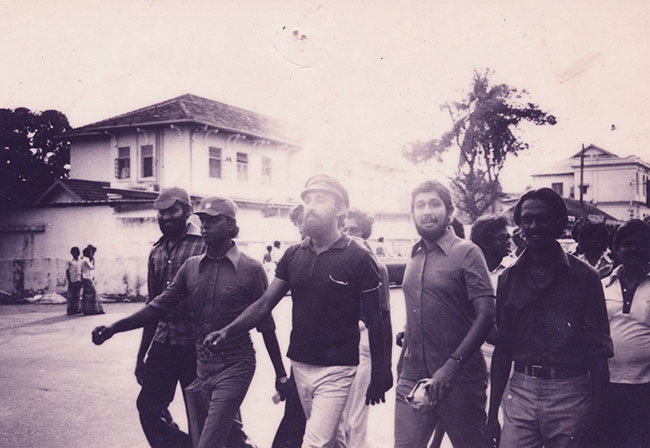
by Rajan Philips
Professor Kumar David will be turning 80 later this week, on July 29. He is most familiar to readers of the Sunday Island as one of its regular columnists – trenchant, funny, irreverent, provocative, but always well informed and substantial. Most readers also know that Kumar David is a great deal more than a weekly columnist. More than occasionally, he has donned his academic cap as a Professor of Electrical Engineering to wade into Sri Lanka’s power and energy sector and its recurrent crises. At least on one occasion he turned his column into a public lecture to his former students at the Ceylon Electricity Board, reminding them of what he taught them at Peradeniya about electricity pricing and asking what on earth they were doing as practicing Engineers in determining consumer electricity tariffs to suit misguided government policy. Often, he uses his space to popularize science in the manner of a dedicated teacher bringing his students up to date with recent advances in science and technology, and revisiting old debates with the enthusiasm of yore but with new information and nuances.
As an Electrical Engineer, Kumar David has scaled the mountain height both in the world of academia and in the power supply and transmission industry. He graduated with First Class Honours in Electrical Engineering from the University of Ceylon in 1963. He was a Commonwealth Scholar for three years (1966-1969) at the Imperial College of Science & Technology, University of London, completing his PhD and DIC in 1969.
He is a Fellow of the Institution of Electrical Engineers in the United Kingdom, Hong Kong and the USA, receiving citations for his contributions to the restructuring of the electricity supply industry and transmission development, which has been his main research area in recent decades. In Sri Lanka, he was appointed to the Board of Directors of the Ceylon Electricity Board when he was 29. He has been an industry consultant in Asian and African countries. He has held visiting professorships and research positions in universities in the US and Sweden.
He taught at Peradeniya for over ten years until 1980, in Zimbabwe for three years (1980-1983), and from 1983 for over 25 years in Hong Kong at the Hong Kong Polytechnic University, where he retired as Dean, Faculty of Engineering. He was the first non-European to become Dean of Engineering at the Hong Kong Polytechnic, which is a centre of excellence for students from China and other neighbouring countries. Kumar David has navigated the rites of passage for generations of students in Sri Lanka, Africa and many Asian countries obtaining their undergraduate and graduate degrees in Engineering.
A Lifelong Sama Samajist
For all his extended sojourns overseas, Kumar David never totally left the country, and certainly not its politics. He remains a Sri Lankan citizen, he is not a (dual) citizen of any other country, and he carries only a Sri Lankan passport. When he began his weekly writings in the Sunday Island 15 years ago, he was beginning his retirement as Dean of Engineering in Hong Kong. To strike a nostalgic note, Kumar David and I belong to a group of Sri Lankans who would be happy to be identified as students of the Hector Abhyavardhana school of political writing. Other and more illustrious members of the group include Tissa Vitarana, Vijaya Kumar, Shantha de Alwis, Chris Rodrigo, Sumanasiri Liyanage, Jayampathy Wickremaratne, Jayantha Somasundaram, and the late Ajith Samaranayake.
Hector, an accomplished Marxist intellectual and LSSP theoretician, never wrote for the mainstream media. First in India (1945-1960) and later in Sri Lanka, he published his own political journals. We wrote for Hector in Sri Lanka. Our foray into mainstream media is a relatively recent development. Interestingly, if not coincidentally, Tissa Vitarana, Kumar David, and yours truly appear practically every week in the Sunday Island. Our political angles are different, but as Bala Tampoe said while appearing on the same platform, in Kandy, with his erstwhile mentor Dr. Colvin R de Silva, soon after Colvin became a United Front Government Minister in 1970, “Our positions may be different, but our priorities should remain the same.”
Kumar David, S. Balakrishnan and I might be the only people alive of the core group that included Fr. Paul Caspersz, Bala Tampoe, Upali Cooray, Jayaratne Maliyagoda, Prins Rajasooriya, Yohan Devananda, and Regi Siriwardena, who launched the Movement for Inter-Racial Justice and Equality (MIRJE) in 1979. Silan Kadirgamar spearheaded the MIRJE Branch in Jaffna. MIRJE fact finding missions visited Jaffna and documented human rights violations during the 1979 Emergency and the burning of the Public Library in 1981. It is pathetic to see now spurious narratives being bandied to falsify the unfalsifiable truth about the burning of the Jaffna Public Library. Be that as it may.
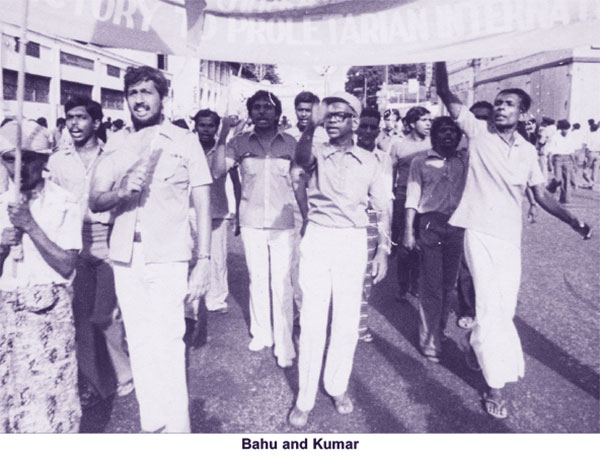
Kumar has been a lifelong political activist. Indeed, a lifelong Sama Samajist. Inspired by the 1953 Hartal, he joined the LSSP Youth Movement at the age of 12. And 68 years on, he has not looked back, but marched on. He became a full Member of the LSSP as a first-year undergraduate in 1960, and functioned as Secretary of the LSSP University Local (Branch). He was one of the two youngest members (the other being Lal Wijeynaike, Lawyer and now of the NPP) at the historic 1964 Conference of the Party. It was a Special Conference held on June 6 and 7, to resolve the ‘coalition question.’ The majority resolution calling for an SLFP-LSSP government moved by NM Perera and 21 Central Committee Members prevailed.
Those who moved the defeated left-opposition resolution rejecting the SLFP-LSSP coalition, including stalwarts like Edmund Samarakoddy and Bala Tampoe, dramatically walked out of the conference and broke away from the Party. As the dust of drama settled, a devastated Kumar David had sunk to the floor below the stage, when a huge hand reaching from above tapped his head and a deep voice followed: “It’s not the end of the world, young man.” It was Colvin, who with Leslie Goonewardene and Bernard Soysa, had moved the “centrist resolution’ calling for a progressive SLFP-ULF government. That resolution was also defeated but they did not leave the Party.
In 1970, Kumar David was one of a triumvirate of young Sama Samajists who set up a secret internal left faction (Vaama Sama Samaja group) within the LSSP. The prime mover was Wickramabahu Karunaratne (Bahu), and the third member was Vasudeva Nanayakkara. All three were rising stars in the LSSP that had just won a massive electoral victory as a coalition partner of the United Front of the SLFP, the LSSP and the CP. Kumar was 29 and Bahu 27, and both were young lecturers in Engineering at Peradeniya. Vasudeva was 31 and the film star face of the future LSSP. Vasudeva and Bahu were members of the LSSP Central Committee and Kumar David was on the Board of Directors of the (Ceylon) Electricity Board. The aim of the secret faction was to restore the LSSP to its pre-1964 roots through an internal struggle from within the Party, without leaving the Party. By 1977, however, all three were outside the LSSP and had launched the new Nava Sama Samaja Party.
1977 also marked the electoral decimation of the Sri Lankan Left, and decimation, as well, of Sri Lanka’s parliamentary system. The terms of politics changed with the new presidential system, the opening of the economy, and the violent eruption of the national question. The end of the internal war in 2009 precipitated new challenges while old problems have kept pressing for new solutions. The base fundamentals have not changed but new superstructural issues have emerged and become dominant. The old generation of leaders, the old Left leaders in particular, who dominated post-independence politics are now gone, and the new generation of politicians who are filling the vacuum are neither well-grounded in the institutions they have inherited, nor are they particularly well equipped to adapt to new changes occurring locally and globally.
It is this new 21st century situation that provides the context for Kumar David’s current political writings. Often, Kumar David disparages what is left of the Old Left as dead Left, and berates and cajoles the JVP to rise above its past follies and seize the current moment and provide a new progressive, secular and pluralistic alternative. He was perhaps the first commentator to call for a single-issue (abolish the presidency) common presidential candidate in 2014, and he was the only observer to raise the alarm even before the 2015 January election (much to the chagrin of many that Kumar was as usual rocking the boat) – that the common candidacy of Maithripala Sirisena was being opportunistically diluted too much to be able to fulfill its historic purpose and potential. Unfortunately, his critical foresight has been proved to be correct. And worse was to follow and has followed. The country that was supposed to recuperate under a new President after the 2019 presidential election, is now in the worst dystopic spiral ever – doubly bound by a global pandemic and government incompetence.
The Intellectual and the Party
Kumar David was born on July 29, 1941, to Ceylon Tamil parents, Benedict and Amybelle David. Kumar credits his mother to have been the greatest influence in his life. He learnt his values from her – the difference between right and wrong, good and evil. His father was a Hulftsdorp Advocate who joined the Judicial Service, served in different parts of the island, and retired as Chief Magistrate Colombo. His maternal grandfather James Joseph was a District Judge, and his maternal uncle Andrew Joseph was a Sri Lankan and UN Diplomat, who retired as Deputy Director UNDP. Kumar’s paternal grandparents and maternal grandfather were Catholics, while his maternal grandmother was a strong Anglican. Kumar also traces his roots to Hinduism through his mother, whose paternal grandfather was a Hindu, who became a Catholic, changing his name from Murugesupillai to Joseph, to marry the young Catholic woman whom he besotted. Kumar’s Catholic forefathers were a well-established Catholic community in Jaffna town. They were benefactors of the local Church and custodians of Jaffna’s St. Mary’s Cathedral parish.
Kumar grew up in Colombo, living in Ratmalana and later in Thimbirigasaya. He went to school at St. Thomas’s College, Mount Lavinia. His university education in Engineering was also in Colombo, as the Engineering Faculty was then located in Colombo until its relocation to Peradeniya in 1964. Kumar’s fascination for Marxism and Left politics and his path to the LSSP were influenced by his stepfather, Lloyd de Silva, who his mother married in 1953. An LSSPer, Lloyd de Silva had a good library of Marxist texts, open to be devoured by someone young, curious and necessarily intelligent. Kumar also became introduced to almost all of the LSSP leaders. Colvin, Bernard and Hector were frequent visitors to their house. Kumar recalls the day after SWRD Bandaranaike’s election victory in 1956, when Colvin R de Silva walked into their house like a huge giant and booming out “Lloyd, tomorrow we are going to have a new government.”
Political organizations play a socializing role in facilitating shared responses to social situations. A revolutionary workers’ party is set up to play, in Leninist terms, a vanguard role and spearhead the cause of social revolution. The party invariably draws on two contradictory segments of society: the social elites from the upper echelons of society carrying the ‘political consciousness’, and dispossessed workers from the bottom drawers of society carrying the ‘psychological consciousness.’ The resulting fusion is what Georg Lukacs called the “imputed consciousness” of the political party. There is also a process of cultural transformation in which, as Hector once described, the worker “enlarges his vision and understanding and acquires the attributes of the highest contemporary human culture; and the elite member “liberates intelligence and knowledge from the vanity of mere intellectual prowess and mellows it with identification and belonging to society as a whole.”
The Lanka Sama Samaja Party, founded in December 1935, was Sri Lanka’s first political party. Its founding leaders, Philip Gunawardena, NM Perera, SA Wickremasinghe, Colvin R de Silva, Leslie Goonewardene – were all young men in their twenties and thirties. Almost all of them were drawn from the highest echelons of Sri Lankan society, but based more on their educational qualifications and accomplishments than by possession of property or any other form of wealth. They were the bearers of a new political consciousness not just for the nascent party but for an entire politically dormant country. For the psychological or experiential consciousness, they turned to the island’s “toiling masses.”
The inaugural manifesto of the Party identified the establishment of a socialist society as “the primary aim” of the Party, the prevailing imperialist rule as the biggest obstacle to political independence and socialist emancipation, and “the toiling masses” as the sole agency to carry out the struggle against imperialism. Thus, the LSSP was born as a bi-modal party, articulating a disciplined cadre component and a positively populist mass base. The founding of the LSSP lit a fire among the island’s intelligentsia and for at least three decades some of the brightest and the best in Sri Lanka were drawn to politics initially because of the LSSP, and later because of both the LSSP and the CP.
The recruitment, or the calling, certainly diminished and dried up presumably after 1964. But during the 1940s, 1950, and even a good part of the 1960s, young pre-university and university students in not insignificant numbers felt inspired to join either of the two Left parties. Kumar David answered his calling when he was twelve inspired by the 1953 Hartal. He was also drawn from the elitist segment of Sri Lankan society, but like many others of his ilk and thanks to the Party he joined, he was able to make a bonfire of inherited vanities and identify his many abilities and attributes with the society as a whole.
Politics without Power
Kumar David and those of his generation joined the LSSP or the CP when the two parties were at the height of their powers. But already in the 1940s, there were developments that would hamstring the Left in general, and the LSSP in particular, in the years after independence. From the very inception of the LSSP, the conservative social and political forces imposed a permanent electoral handicap on the Party by characterizing it as a low-caste, anti-religious, and pro-Indian Party. Another handicap, involving language, would be added after independence.
The proscription (1940-1945) of the LSSP by the colonial government and the attendant expulsion (1940-1947) of NM Perera and Philip Gunawardena from the State Council precluded the Party from open political activity. In their four years in State Council NM and Philip, even without ministerial powers, laid the bedrock foundation for Sri Lanka’s social welfarism. The years of proscription and the expulsion were lost years for the LSSP, which could never be fully recuperated.
Even so, the LSSP resumed politics with a bang and independence arrived in 1948, earlier than anyone expected and accelerated by the 1947 strike. The 12 August 1953 Hartal was certainly the highest point of mass activity in Sri Lanka’s history. The Hartal which began with strike action by workers was soon overtaken by the protesting energy of the “toiling masses.” The Hartal enhanced the political muscle of the Left, but not its electoral fortunes. Its ultimate outcome was the defeat of the UNP government in 1956, and the election of the MEP-SLFP coalition under SWRD Bandaranaike that included the Philip Gunawardena (MEP) faction of the old LSSP.
The SLFP that reaped the rewards in 1956 had stood on the sidelines in 1953. It may not be widely known now, but the only other party in parliament to fully join the Left Parties in the Hartal was the Tamil Federal Party. As well, the victory of the MEP-SLFP coalition was ensured by the no-contest agreement it had with the LSSP and the CP to avoid inter-party vote splitting. In March 1960, the LSSP made an all-out but unsuccessful attempt to form a government on its own. The 1960 failure was the beginning of formal coalition politics that led to the formation of the United Front government in 1970.
The years and decades after 1953 and 1964 have seen recurrent questions and criticisms about the alleged failure of the two Left Parties to seize the apparently revolutionary opportunity that emerged at the height of the 1953 Hartal, and their drift to coalition politics after 1960. In his “Revolutionary Idealism and Parliamentary Politics,” the late Ranjith Amerasinghe has provided a committedly scholarly assessment of the LSSP’s role both in 1953 and 1964, and locates them in a historical perspective while focusing on the Party’s “ideological and organizational adaptation to a Westminster–model parliamentary system.” But these weighty questions will perennially persist, even though in Sri Lanka’s current situation, when corrupt charlatanism is in the saddle and running (rather ruining) the country, it would be both a tragedy and a farce to raise them even esoterically.
As I noted at the outset, Bahu, Vasu and Kumar attempted to address these questions critically from within the LSSP beginning in 1970. The course of events after 1977 within Sri Lanka and outside have exposed the global forces that have been at play, and over which no Left Party anywhere in the world has been able to have any sway within the traditional revolutionary perspective that Left Parties have been functioning until then. Kumar David has consistently drawn attention to these global changes, principally the collapse of the socialist second world and its integration in the global market, and tried to redefine the terms of engagement for the Left in Sri Lanka. Kumar and Bahu have also been consistent in their criticisms of the LSSP leadership for the 1972 Constitution that was a total repudiation of everything that the LSSP stood for on the national question, in 1956, and dearly paid for.
In fairness, the two Left Parties and anyone and everyone ever associated with the Left in Sri Lanka have rallied to support the Thirteenth Amendment as a constitutional solution to the national question. In addition, the two founding leaders of the LSSP, NM and Colvin, have left behind a powerful legacy of opposition to the wholly abominable albatross created by the 1978 Constitution. It will not be an exaggeration to say that in his own way Kumar David has been carrying the same torch of opposition for nearly 15 years, and constantly reminding those in parliament that it is their business to operationalize this opposition in a practical way.
The LSSP has been a quintessentially opposition party, and it is this characteristic that has made the pursuit of politics worthwhile even when it does not lead to its ultimate consummation with power. At 80, Kumar David is possessed of the same passion for positive opposition as he was when he was 12, at the time of the Great Hartal. Over the years, he has scaled academic mountains, fought the good political fight, kept the socialist faith, but is not ready to call off the race. He deserves a break, at least, to celebrate his 80th birthday with his wife Rohini, son Amrit, his grandchildren, and his extended family. We say: Many Happy Returns!
Features
Emotions, learning, and democracy: Reviving the spirit of education
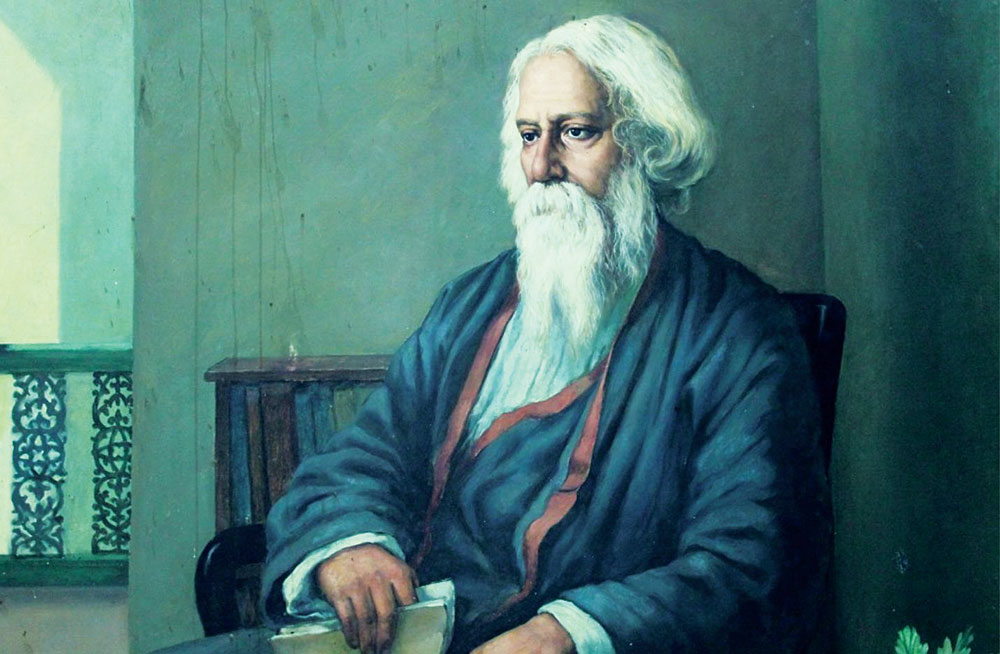
When a father becomes a gambler and his obligation to his family takes the secondary place in his mind, he is no longer a man, but an automaton led by the power of greed.
(Tagore, Nationalism, 2018)
(Excerpts of the keynote address at Annual Sessions at the Faculty of Education, The Open University of Sri Lanka––Empowering Minds: Education for New Era.)
As I am coming from the Humanities and Social Sciences and Performance Studies disciplines, I have a close affinity with education and education philosophy. I have also been engaged in the current debate on higher education, writing and presenting my ideas with the academia and the public domains. I have been motivated by the like-minded scholars (Senanayake, 2021; Amarakeerthi, 2013; Uyangoda, 2017 & 2023; Rambukwella, 2024; Jayasinghe & Fernando 2023; & Jayasinghe 2024) who have been continually discussing problems related to our education and the role of humanities and aesthetics within this sphere. Some of the recurrent themes I have raised in these writings are burning issues in our current education scenario.
Among them, the indoctrination, decline of the arts and aesthetic education in our education sector, and the importance of creative arts in human development were prominent. Hence, in today’s speech, I will continue this discussion and try to broaden the scope of it. The theme of today’s speech can be categorized in three areas of studies: emotions, education, and democracy. What I am going to present today is the role of emotion in education and how this new paradigm of education could lead to the democratic establishments in society. In this speech, I try to build a connection between these key areas of arts and aesthetic education, its vital ingredient of empathy, and how this empathic education supports democracy in the society. This argument will be further elaborated in the course of my talk.
We, as a nation, are on the verge of a transition. This transition has been gradually taking place in our society through the influences of neo liberal economic and political changes happening throughout the region. The glory of our free education system and the heritage we envisioned have also been challenged by the new developments of private educational institutions. These new trends have distorted the true meanings while diminishing the philosophical and moral values of education.
It is the skill acquisition that has come to the fore of the educational discourse. Skills that can be used in the social milieu, and can support the economic growth of the country have been commissioned for our curricula. This mantra has been circulated and supported by the governments which ruled this country for decades. We, as academics, have also adopted strategies to cater these policies to indoctrinate our children to become future entrepreneurs. All the philosophical and moral values of education have been reduced to produce mere labourers. Education is interpreted as a commodity, which is being sold in the market based on supply and demand. We are advised that if we cannot compete in the market, our survival is at stake.
Now, who are we? And, where are we? Where is our society heading? These simple but vital questions are important for us to rethink how we educate our children and what we gain out of it. What kind of society we have created today, as a whole after implementing those educational policies imposed by the authorities? Over the past few years, the world has gone through a myriad obstacles and difficulties facing a worldwide pandemic and devastating wars. After many centuries, we faced the Covid-19 pandemic which challenged us on how we live as a community. Over two years, we were locked down and were isolated from the world. We were locked down in our own houses and the social distancing was imposed reframing ourselves to be connected with each other.
Pandemic, Aragalaya and emotions
Pandemic introduced different ways of learning and teaching in our education sector. The traditional ways of teaching and learning were replaced by the online modes of learning. We started conducting seminars and lectures through online zoom technology and other modes to connect with our students. Students, somehow or other, connected with us through their mobile phones and other devices. The conception behind all these technological advancements implied that the education can be successfully delivered via online mode, and the cost can also be reduced drastically allowing the government to reduce the cost of education and infrastructure.
However, the vital concepts in the educational business, such as corporeality, subjectivity, intersubjectivity, temporality, and spatiality have been redefined and challenged. The learning and teaching were redefined in the virtual reality, reducing the values of interpersonal and corporeal connections between learners. We tend to believe that it is not important for the learner to be present in front of other learners but is enough for her or his virtual avatar to be present.
Soon after the taming of the pandemic situation, our society was shattered with the economic bankruptcy and social upheavals. The financial hardship experienced by the people of the country, resulted in demand for basic needs, cooking gas, petrol, and other important rations. Vigil and silent protests, followed by the mass movements and occupation, ignited the country’s largest non-party people’s struggle, Aragalaya.
Youth of the country encamped the Galle Face Green, and established alternative communal spaces. Cinema, school, community kitchen and even an alternative people’s university were established. Within a few days, many GotaGoGama encampments were established in major cities of the country demanding the President and the Parliament to resign. The new people’s democracy was established by people, for people. This mass movement not only showed us new ways of governing the country but also new ways of living as a community. Human connection and communal living were established until the military actions uprooted the GotaGoGama encampment.
You must be wondering why I am trying to recall this unpleasant past of our social memory. Why is it important for us to go back and see how we passed this phase of time and have come to this point today? As my key ideas are related to emotional education, empathy, arts, and democracy, it is important for us to revisit such a brutal past and learn lessons from it. The pandemic situation taught us how it is important for us, as human beings, to be connected and live with each other as a society.
The pandemic taught us the importance of revisiting communal life, which has sustained and enriched our lives for centuries. Aragalaya further emphasised the importance of communal struggle and co-living in order for us to establish a democratic society. Democracy cannot be sustained without human engagement. It is not something that the ruling government or an alien authority donates to us. It is something that is generated through human connections and collective will. If we clearly scrutinise those two phenomena we experienced in the recent past, it is evident that in the first phenomenon, the pandemic challenged our emotional engagement with others. In the second phenomenon, Aragalaya, we witnessed how important emotions are to reconnect with people and demand for democracy.
Anxiety of our time
Today, as educators, we are on the verge of resolving complex issues related to education. Information technology and AI have invaded the traditional teaching and leaning approaches. The role of the teacher is being challenged and also being shifted by artificial intelligence. The question arises, whether we have a key role to play in the lecture theatre or in the classroom when AI invades our positions. With technological advancement and artificial intelligence, our role as teachers and also what we teach are being challenged. Now, the question is what educational philosophy or theory is suitable for us to guide our next generation of learners’ what methods are appropriate for this new generation to learn and become valuable citizens for the country.
The argument that I want to bring forward is that in our education, we lost the key ingredient, which is the affective development in learning. In other words, we have not focused on how our learners should be equipped with emotional educational principles. Affective components of our education were marginalised or forgotten in favour of promoting skill development or manual learning. One of the reasons behind this lack is the way we conceptualised our educational policies, defining education in dichotomous ways.
For instance, as philosopher john Dewey says, ‘theory and practice, individual and group, public and private, method and subject matter, mind and behaviour, means and ends, and culture and vocation’ (Palmer et al., 2002, p. 197) are the ways that we defined our educational principles. Dewey’s educational philosophy is based on the key principle that the children should learn in the classroom where they learn the society through ‘miniature community and or embryonic society’ (Palmer et al., 2002, p. 196). It is vital for the students to learn this communal living, because in the larger canvas, they learn to live in the democratic society as elders. Communal empathy is thus a vital component in developing a healthy, democratic and caring society where each person has a place and respect.
Today, we focus on education, but the truth is we are living in a paradoxical era. Bruzzone (2024) argues that with this pandemic situation, the ongoing conflict between developed nations, and also the advancement of television and online technology, our young generation is in a conundrum. Living in these complex social terrains, our young generation is experiencing complex inner upheavals. He argues that,
The rhetoric of happiness and the entertainment industry keep children and adolescents in a state of intermittent distraction that prevents them from exploring their inner self, including its less appealing, grey areas. Cinema, TV, and video games elicit strong emotions, helping the young to evade the desert of boredom and apathy (Bruzzone, 2024, p.2).
Even though our young people are equipped with devices throughout their livelihood, more or less they are isolated. The media always exaggerates that with mobile technology and other online devices, we are connected to the world and are not isolated.
We also tend to think that we are a part of global citizenship. However, the truth is that most of us are becoming isolated though we are connected with others through technology. Hence, Bruzzone argues that in order to overcome such isolation, existential vacuum and indifference, people tend to experience adrenaline rushes through various risk behaviours, speeding, loud music, and psychotropic substances (Bruzzone, 2024).
Affective life
What I argue here is not to give up our engagements with the new technology or devices but to find ways of reawakening our emotional life within us. This affective life is still hidden in our life that our learners do not know how to find it; or rather, we have not taught them to unlock this emotional life within. Our education, as I argued earlier, does not have such intention or components where the learners can be equipped with emotional intelligence.
We have thrown away all the important aspects of such components in our educational system in favour of developing manual learners. These manual learners do not have such empathic life, affection, or emotional intelligence to deal with their own emotional lives, or they do not have knowledge to deal with others in the society. The result is what we have today: the merciless society where people are competing with each other to accumulate material wealth. Citing Galimberti (2007), Bruzzone further argues how this can create a societal issue when the individual cannot cope with his/her emotional life:
This inability to express and share emotions can sometimes explode, taking the form of uncontrolled aggression and impulsive and maladaptive ways of acting out: when this occurs, unacknowledged emotional experiences (of anger, frustration, a sense of inadequacy, fear, and so on) turn into words or acts of hatred and violence—usually towards vulnerable individuals–,flagging a growing dis-connect between acting, reasoning, and feeling: the heart is not in tune with thought nor thought with action (Bruzzone, 2024, p. 2).
Thus, our education has created this person who is struggling to connect with the heart; heart with the thought and thought with action. This dislocation of the heart with thought and action has resulted in developing antipathy towards the society. This antipathy also destabilizes the democratic social value systems. If we really need to re-establish a democratic society, we should first focus on our existing education system.
It is not all about how we integrate new technology and equipment to facilitate our learners but it is about how we allow our learners to first unlock their emotional life, and secondly think how they reconnect with the society. A new educational approach should be tailored to facilitate this vital objective. Hence, let me briefly discuss how creative arts and aesthetics can be useful for developing such individuals who will be empathic as well as critical towards the social changes taking place in this millennium.
At this juncture, it is important to revisit one of the key thinkers and an educational philosopher, Rabindranath Tagore. Tagore is one of the few philosophers who have been thinking and developing an alternative learning approach through his Vishva Bharathi concept. He established Shanti Niketan where this new approach was primarily being tested. Encapsulating his philosophy of learning, he argued,
For us, the highest purpose of this world is not merely living in it, knowing it and making use of it, but realizing ourselves through expansion of sympathy and not dominating it, but comprehending and uniting it with ourselves in perfect union (Bhattacharya, 2014, p. 60).
As this statement clearly indicates, Tagore’s vision of education is developed for cultivating sympathy towards other humans and the environment alike. This education does not persuade the learner to think about his/her environment as something that can be commodified and utilized as material. The environment where the individual is living is also a living entity that is intertwined with human beings. Therefore, the individual should think in a different way to converge with the environment and find a place for co-living. In order to establish such an empathic educational approach, we need a different mode of educating young people. This Tagorean approach to education clearly emphasizes the value of the affective nature of education. It is the emotional life of the individual which is focused and cultivated through various means of teaching and learning.
Emotion and democracy
As of today, we lack this vital emotional component in our education. One of the fallacies behind this situation is that we tend to believe that emotions reside within ourselves, and they are private and personal. This is a misconception that is being sustained through our existing systems of education. However, on the contrary, emotions do not only provide richness to our own personal lives but they are also the primal tool that connects us with the outer world. In other words, we connect with other human beings in the society through our emotional arc. If the individual disconnects the communal engagement, this can result in destructive mannerism.
‘This disintegration of reciprocity, which weakens the social fabric, effectively leaves the individual isolated in a state of loneliness and uncertainty’ (Bruzzone, 2024, p. 13). This isolation and uncertainties of individuals can also have a negative impact on the healthy relationship with communities and, largely, on the democratic institutions. As scholars argue, this can be resulted in sustaining endogamous, xenophobic and violent neo-tribal grouping that have mushroomed in our society. This is what we have seen in the form of various nationalist upheavals in our society for the last few decades.
This tendency, therefore, leads us to further think about the value of emotional education and also its role in communal living. Further, emotions and emotional competency lead us to engage with other subjects, and also emphasizes that it is a bridge that is built between you and me and the world. When this bridge is broken, our connections between myself, you, and the world could be destabilized and shattered.
That is why scholars such as Bruzzone argue that ‘affectivity is also an ethical and political issue’ (Bruzzone, 2024, p. 12). It is ethical in the sense that my engagement or disengagement with the social beings are formed and developed through the emotional desires that I have inherited. Further, it is political, because, when the individual assumes that his/her existence relies on the communal existence, this assumption leads to political action of individuals. Hence, emotional education is vital for the healthy existence of a society. Cusinato, therefore, states that ‘emotional education is at the core of democracy’ (Cusinato Cited by Bruzzone, 2024, p, 13).
Finally, I would like to highlight one of the brilliant minds of our time, Prof Martha C. Nussbaum and her ideas on why arts education is vital for a continuation of democracy, and also how emotional education is important to achieve this (Helsinki Collegium, 2024). Today, as a civilization, we are confronting various and complex issues threatening the continuation of the human race. These key issues are not limited to countries or nations. They are applicable to all human beings currently living in the world.
Environmental crisis, global warming, food security, poverty, and war are some of the recurrent issues we face today. In order to focus on these larger humanitarian crises, how could we equip our students to think in broader ways to tackle these complex issues? Nussbaum provides us some important points to think on how we could design our education system where the individual can be more empathetic and passionately engage with worldly phenomena. According to her, we need citizens who have the capacity to think and see the world as other people see the world; need to develop the capacity for genuine concern of others, near and distant; teach real things about other groups in the society and learn to reject stereotypes; and promote accountability and critical thinking, ‘the skill and courage it requires to raise a dissenting voice’ (Nussbaum, 2016, p. 45-46).
Conclusion
Nussbaum’s recent works largely focus on how human emotions are connected to the establishment of democratic societies in the world. Arts, culture, and humanities play significant role in promoting positive emotions amongst participants. It also promotes wellbeing and happiness which are vital for a healthy society. Today, we have a new government. This government often emphasizes the importance of investing in education, from primary levels to higher education. They have shown the commitment to change the existing stale education systems which need drastic and constructive criticisms to change for a better system. Thus, we, as educators, thoroughly believe that it is time for us to revisit what we have taught and how we have taught our younger generation for decades. It is time for us to rethink new ways of tailoring our education system where we could promote empathy and develop empathetic citizens who care about others and the environment we live in.
Thank you.
References
Bhattacharya, Kumkum. 2014. Rabindranath Tagore: Adventure of Ideas and Innovative Practices in Education. Cham: Springer International Publishing.
Bruzzone, Daniele. 2024. Emotional Life: Phenomenology, Education and Care. Springer Nature.
Harshana Rambukwella. 2024. “The Cultural Life of Democracy: Notes on Popular Sovereignty, Culture and Arts in Sri Lanka’s Aragalaya.” South Asian Review, July, 1–16.https://doi.org/10.1080/02759527.2024.2380179 .
Helsinki Collegium. 2024. “Democracy and Emotions– a Dialogue with Philosopher Martha C. Nussbaum.” YouTube. June 6, 2024. https://www.youtube.com/watch?v=p3xdcfbE3KA.
Jayasinghe, Saroj. 2024. “Arts and Humanities in Medical Education: Current and Future.” Jaffna Medical Journal 36 (1): 3–6. https://doi.org/10.4038/jmj.v36i1.202.
Jayasinghe, Saroj, and Santhushya Fernando. 2023. “Developments in Medical Humanities in Sri Lanka: A Call for Regional and Global Action.” The Asia Pacific Scholar 8 (4): 1–4.https://doi.org/10.29060/taps.2023-8-4/gp2878.
Karunanayake, Panduka. 2021. Ruptures in Sri Lanka’s Education: Genesis, Present Status and Reflections. Nugegoda: Sarasavi Publishers.
Nussbaum, Martha C. 2016. Not for Profit Why Democracy Needs the Humanities. Princeton University Press.
Palmer, Joy, David Cooper, and Liora Bresler, eds. 2002. Fifty Major Thinkers on Education. Routledge.
Uyangoda, Jayadeva, ed. 2023. Democracy and Democratisation in Sri Lanka: Paths, Trends and Imaginations. 1st ed. Vol. 1 and 2. Colombo: Bandaranaike Centre for International Studies.
Short bio of the speaker
Saumya Liyanage (PhD) is an actor both in theatre and film and also working as a professor in Drama and Theatre at the Department of Theatre Ballet and Modern Dance, Faculty of Dance and Drama, University of the Visual and Performing Arts (UVPA), Colombo, Sri Lanka. Professor Liyanage was the former Dean of the Faculty of Graduate Studies, UVPA Colombo and currently holds the position of the Director of the Social Reconciliation Centre, UVPA Colombo.
Acknowledgements
The author wishes to thank Himansi Dehigama for proofreading the final manuscript of this keynote speech.
This keynote is delivered at the annual sessions of the Faculty of Education, Open University of Sri Lanka on the 6th of February 2025.
by Professor Saumya Liyanage
(BA Kelaniya, MCA Flinders, Australia, PhD La Trobe, Australia)
Department of Theatre Ballet and Modern Dance
Faculty of Dance and Drama
University of Visual and Performing Arts, Colombo, Sri Lanka
Features
Achieving an arduous task: Comparing philosophies
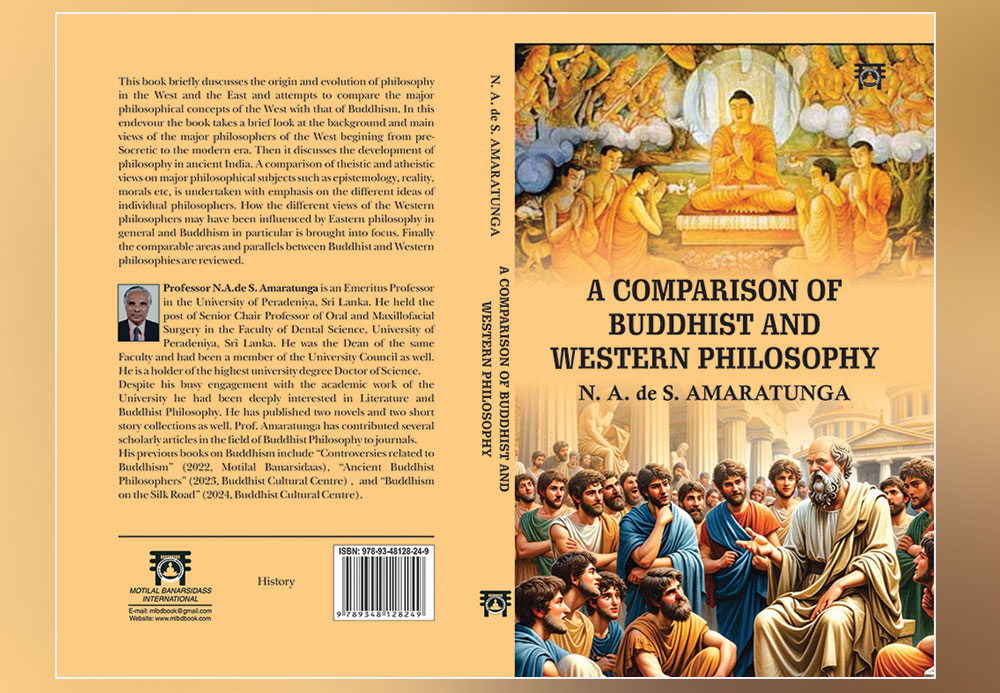
Review of Prof. N.A. de S. Amaratunga’s book:
‘A COMPARISON OF BUDDHIST AND WESTERN PHILOSOPHY’
Prof. Asoka Amaratunga is well known to the readers of The Island by his regular contributions on many topics, including Buddhism, but what is less well known is that he has authored several books on Buddhism. He seems to have well used his retirement from the Faculty of Dental Science, University of Peradeniya in 2006, as he has published four books titled; “Controversies related to Buddhism”, “Ancient Buddhist Philosophers”, “Buddhism on the Silk Road” and the latest “A Comparison of Buddhist and Western Philosophy” which is the subject of this review. A fifth titled “Maithreyanatha, Asanga, and Vasubandu – Their Life and Philosophy” is already in print.
No sooner had I started reading this valuable work than I realised what an arduous task it would have been to write, as I found great difficulty in grasping the meaning of the multitude of terms used in philosophy! Fortunately, he has taken the time and the effort to explain these terms making this book an excellent introduction to philosophy for novices, myself included. However, the scope of the work is much more significant in that it illustrates how Buddhist philosophy has heavily influenced late Western philosophy; an inference I have drawn by reading the book, though the author is less emphatic, perhaps leaving the reader to come to own conclusions based on the facts presented, which I consider a great strength of this book. It is a painstakingly crafted book which goes in to detail and, by the very nature of the subject, a difficult read but appropriate repetitions make the job of the reader easier.
Though there are similarities in the thinking of early Greek philosophers like Socrates, Plato, and Aristotle with the teachings of the Buddha, Prof Amaratunga argues against any influence and states:
“If we consider the comparable periods of the life span of these philosophers it is seen that Buddha lived from 624 – 544 BCE which is the accepted dating in Sri Lankan and South Asian tradition. On the other hand, Greek philosopher Socrates’ life span was from 470 – 399 BCE. Socrates was born more than hundred years after the death of Buddha. On the other hand, Thales of Miletus who is considered the father of philosophy lived during 624 – 546 BCE which closely match the Buddha’s life period. However, there would not have been well developed means of communication between East and West in those early times. Greece was positioned between the west and the east as it were and may have acted as a conduit for transmission of culture and knowledge in either direction but for this to happen roadways had to be built connecting these regions which may not have happened during Buddha’s and Socrates’ time. The oldest global trade route is believed to be the Silk Road which came into partial existence in the 300 BCE and was connected to the West in the 200 BCE. Active trade between the two civilisations began in 100 BCE. Cultural exchanges between the West and the East would have happened since 100 BCE”.
Though in this paragraph, commencing the final chapter of the book, Asoka mentions that the Buddha lived from 624 to 544 BCE and that Socrates was born more than hundred years after the death of the Buddha, in the preceding pages he refers to Socrates as a contemporary of the Buddha and that Buddhism started in the 5th century BCE. Perhaps, this happened because the date of birth of the Buddha is a continuing argument, some authorities opining that it is hundred years after the date accepted in our tradition. Though some speculate whether some of the ideas of Socrates were influenced by the teachings of Buddha, as there are similarities, lack of means of communication makes it unlikely. Interestingly, some experts have opined in the past that the Buddha was influenced by Socrates!
I must point out another error; in reference to Christianity he states: “Christianity began as a sect of Judaism and remained so for centuries until it perceived itself as a separate religion in the 4th Century AD. It spread widely and grew to be a world religion in the 21st Century.”
Perhaps, he meant that Christianity spread widely to be the most embraced religion and continues to do so even in the 21st century, despite dwindling numbers.
The book starts with a chapter on the influence of ancient migration on the development of philosophy, followed by several chapters on the development of Western philosophy up to modern times. He then progresses to Indian philosophy including Buddhist philosophy followed by a chapter on Epistemology. Several chapters then follow comparing Buddhist and Western philosophy dealing with the subjects of Reality, Mind and Psychology, Morals, Karma and Rebirth, Causality, God and the origin of the Universe, Evil, Freedom/Salvation, Idealism, Matter, Universe, Truth, Logic and concludes with a chapter drawing parallels between Buddhist and Western philosophies.
He refers repeatedly to similarities of William James’ views to that of Buddha but Dr Upali Abeysiri, retired Consultant Surgeon who has also written many books on Buddhism, comments:
“The Buddha also showed that the psyche is not a permanent entity but consists of a stream of units arising and ceasing. However, Western scientists attribute the first description of the momentary nature of consciousness to William James, the nineteenth century American philosopher who is considered the father of American philosophy.” (Many firsts of the Buddha; The Island, 3March 2025).
It is a shame that Westerners do not give credit to the pioneering efforts of the Buddha but books of this nature continue to highlight the fact that the Buddha’s thinking was far ahead of times and relevant even today; perhaps, for ever!
Asoka has done a great service by bringing out this analytical publication which should appeal to anyone from novices to philosophy, to those interested in Western philosophy as well as advanced aspects of Buddhist philosophy, which seems to have developed further after the Parinibbana of the Buddha, as well explained. I have educated myself and would highly recommend this book. The hard work put in to compiling this, in meticulous detail, justifies the concluding remarks:
“It is seen that there had been philosophers both in the West and in the Indian Subcontinent and in ancient times as well as modern who held contrasting as well as similar views on most of the important subjects of philosophy like epistemology, reality, mind, creation, God, morals, truth, universe, matter etc. There were and are empiricists and rationalists, realists and idealists, theists, and atheists. There were philosophers who thought origin of morals, knowledge, truth, matter, salvation etc. was God and there were others who thought the opposite. Theists attempted to justify evil as it is a creation of God according to their belief.
Buddhism based its beliefs in most of these philosophical subjects on its foundation of “anicca, dukkha, anatta”. Suffering which resulted from this natural state of the world and life formed the main focus in Buddhism. Buddha had found the cause of suffering, and the solution as discoursed in the Four Noble Truths. The path was based on a foundation of moral practice and there was no god or any other agent involved in the individual effort. Buddha and other Buddhist philosophers who followed him grounded their philosophy on Buddhist morals. Further Buddhism does not see the world as evil but the self-ego of human beings which distorts perception may create evil. Human craving is caused by this wrongful perception and craving in turn causes suffering. Several Western philosophers have been influenced by and, also, agreed with aspects of Buddhism.”
By Dr Upul Wijayawardhana
Features
Professor Herbert Allan Aponso : ‘The Great Centenarian’
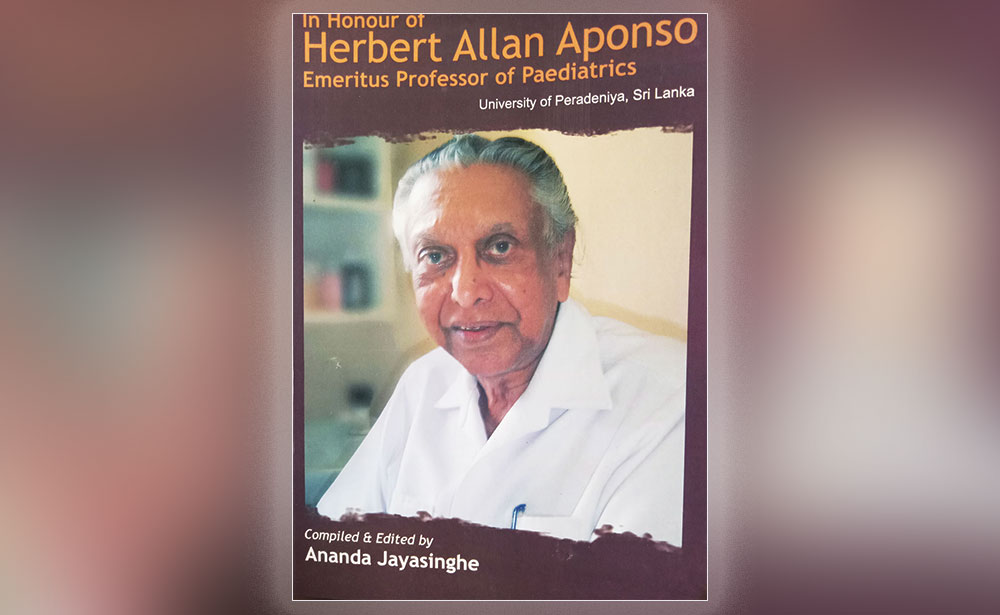
Herbert Allan Aponso, a true legend, the doyen of Paediatrics / Child Health, Professor Emeritus celebrated his 100th birthday on the 25th of March 2025, thus becoming a centenarian.
What a rare and glorious moment of anyone’s life!
I simply cannot recall any university academic achieving this exceptional milestone in Sri Lanka.
Born on the 25th of March 1925 in Lakshapathiya, Moratuwa, Professor Aponso has witnessed and thrived through a century of immense global change. It is fascinating to reflect on the world and Sri Lanka as they were in 1925. At that time, Sri Lanka (then Ceylon) was still a British colony, 23 years away from independence, with a population of just 4 million and an average life expectancy was below 40 years.
The world political map in 1925, was vastly different from that of today. One single large India without Pakistan and Bangladesh, one single Korea, no official Israel, and it was just three years after the fall of Ottoman Empire.
In the medical field, too, no United Nations, no WHO, no antibiotics, no blood banks, and no organised immunisation programmes. Diseases such as smallpox posed a dire threat to humanity, and devastating epidemics, such as the malaria outbreak in Ceylon in the early 1930s, resulted in negative population growth for the first time in history. Professor Aponso has survived through all these extreme challenging threats over the past one hundred years!
In 1964, he joined the Department of Paediatrics as a Senior Lecturer at Sri Lanka’s (then Ceylon) newly established second medical faculty, Peradeniya thus becoming a pioneer academic staff member of the Faculty of Medicine. He played a very vital role in teaching many a generation of doctors.
His brave decision to leave the position as Senior Lecturer at Faculty of Medicine, Colombo and relocate with his family to Peradeniya, is truly beyond belief as he left his birthplace and the more affluent Colombo life. At the time, the small town of Peradeniya was considered distinctly remote and less privileged.
He then became the quintessential ‘Peradeniya Man’, getting involved in the establishment of Kandy Society of Medicine (KSM), Peradeniya Medical school Alumni Association (PeMSAA) and in consolidating both the Department of Paediatrics and the Faculty of Medicine.
He retired from university service in 1993 after three decades of dedicated and remarkable service to the Faculty of Medicine and to the medical fraternity at large.
All staff members of Faculty of Medicine, Peradeniya and elsewhere who graduated before 1993 have invariably had exposure to his teaching, including myself and my wife Chandrika.
I also had the privilege of serving as Registrar in Paediatrics between 1985 and 1987 under his wing.
He is also blessed with three very caring children – Ajith, (Dr) Heshan and (Dr) Charmalie and many grandchildren and great grandchildren, all of whom care for him and look after him very well.
Professor Aponso is truly amazing and is perhaps the most complete man we can ever imagine, as he is a combination of numerous rare features moulded into one person. He has an attractive and gentle yet commanding personality, authority of a different kind, intelligence, kindness, passion, calm mind, commitment, high social standing and blessed with happy and exceptionally high-quality long life along with his gracious late wife (sadly passed away in 2017) Mrs Vimala Aponso and three caring children,
A devout Christian, Professor Aponso’s faith has been a guiding force throughout his life. At the same time, he has always recognised and respected the values of other faiths, particularly Buddhism. He often quoted the Buddhist scripture:
“Pûjâ ca pûjanîyânam” (Honour those who are worthy of honour) – Khp 5, Maṅgala Sutta.
This is well and truly appropriate and relevant to him.
He is a true legend of our time and above all a great human being.
I wish him a HAPPY 100TH BIRTHDAY!
Ananda Jayasinghe
(Retired Professor in Community Medicine, Faculty of Medicine, University of Peradeniya)
-
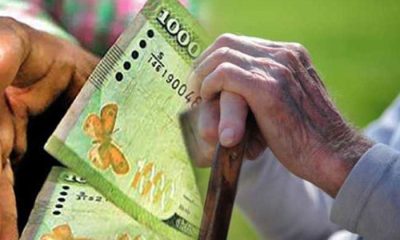
 News6 days ago
News6 days agoSeniors welcome three percent increase in deposit rates
-
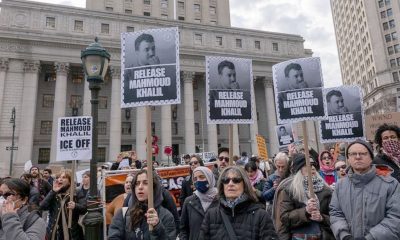
 Features6 days ago
Features6 days agoThe US, Israel, Palestine, and Mahmoud Khalil
-
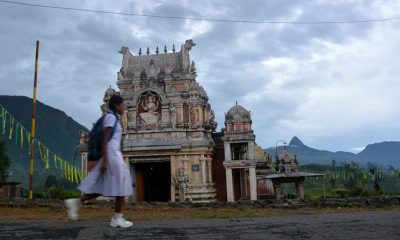
 News6 days ago
News6 days agoScholarships for children of estate workers now open
-
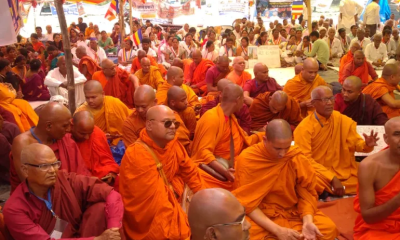
 Foreign News5 days ago
Foreign News5 days agoBuddhism’s holiest site erupts in protests over Hindu ‘control’ of shrine
-
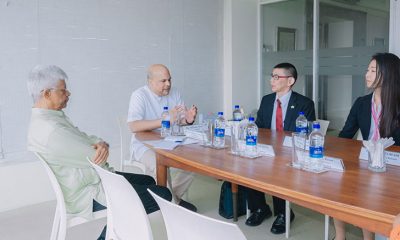
 News6 days ago
News6 days agoJapanese Defence Delegation visits Pathfinder
-
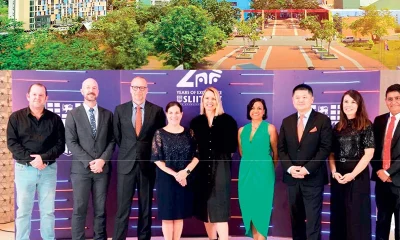
 Features3 days ago
Features3 days agoCelebrating 25 Years of Excellence: The Silver Jubilee of SLIIT – PART I
-

 Editorial5 days ago
Editorial5 days agoWhen tractors become cars!
-
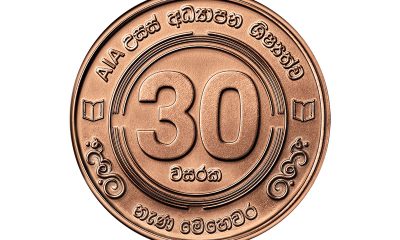
 Business1 day ago
Business1 day agoAIA Higher Education Scholarships Programme celebrating 30-year journey








